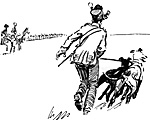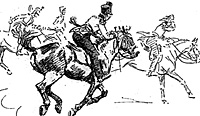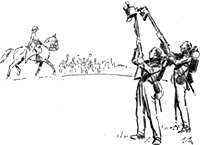The sport of cousing was in great favour with the officers of the Peninsular Army, particularly when it lay behind the lines of Torres Vedras.
Meetings and individual matches were frequent, and hares, not being in possession of the necessary information to differentiate between enemy and British territory, frequently took their pursuing greyhounds into the French lines. On at least one occasion it is recorded that a well-known dog, which had thus involuntarily found itself a prisoner, was returned the following day under a flag of truce.
Wellington's "Course"
Wellington himself was later the principal in a yet more spectacular "course" which was much talked of in the Army at the time.
 After the storming of Badajoz in the beginning of 1812,
Marechal Marmont again invaded Portugal from the northward,
much to the consternation of the Portuguese Militia, whose
business it was to defend it.
After the storming of Badajoz in the beginning of 1812,
Marechal Marmont again invaded Portugal from the northward,
much to the consternation of the Portuguese Militia, whose
business it was to defend it.
The regular Portuguese troops, officered largely by British officers, had done well during their service in the Field with the British Army - in particular the Artillery. The Militia, however, on this occasion - unleavened by sufficient British element to invigorate them - did not wait for the report of the enemy cannon to remove themselves from the danger zone, but left on the rumour of their approach!
Marshal Beresford, then engaged in the reorganisation of the Portuguese Army, after giving them a good dressing-down in General Orders directed that each regiment concerned should lodge its Colours in the Town Hall of its respective district until they had provided themselves with a pair from the ranks of the enemy.
A contemporary writer states that he "never heard that any of them were redeemed in the manner prescribed." The details of the operations that followed, leading eventually to the well-known battle in the neighbourhood of Salamanca, (wherein the French General became a casualty) do not affect this narrative. The middle of June saw the British Forces in occupation of the heights of St. Christoval; an unsheltered, open ridge of country, unfurnished with either wood for bivouac fires or water to drink. Below them stretched a plain; upon which Marmont descended, covered by a heavy cannonade of artillery, and placed his army almost within gunshot of their opponents who now had in their rear the town of Salamanca, evacuated by the French upon their approach.
Wellington "Old Douro"
Then occurred an incident which demonstrates how "Old Douro," - as Wellington was known to the rank and file, retained the respect of a sport-loving soldiery in spite of the severity of his disciplinary outlook and his conviction that the lash was the only method of controlling them.
 As the British Line stood ranked upon the heights, and whilst the
French cannon-balls played upon them to cover the manoeuvres of the
many-coloured masses on the plains below, Lord Wellington rode slowly
past the regiments, accompanied by a numerous staff. The summer
afternoon was drawing to a close. The British troops, standing in line as was
their wont and supported by their Portuguese allies, were receiving the fire
from the French artillery with their accustomed stoicism. A few batteries
were replying to this elevated discharge, but the majority of the Allied artillery
was not engaged, whilst their cavalry were all disposed in rear and out of
range. Below them the French columns wheeled and turned as at a review,
whilst bodies of cavalry, cuirassiers, big men on big horses, dragoons,
chasseurs-a-cheval, and false-whiskered hussars stood on either flank for
their protection.
As the British Line stood ranked upon the heights, and whilst the
French cannon-balls played upon them to cover the manoeuvres of the
many-coloured masses on the plains below, Lord Wellington rode slowly
past the regiments, accompanied by a numerous staff. The summer
afternoon was drawing to a close. The British troops, standing in line as was
their wont and supported by their Portuguese allies, were receiving the fire
from the French artillery with their accustomed stoicism. A few batteries
were replying to this elevated discharge, but the majority of the Allied artillery
was not engaged, whilst their cavalry were all disposed in rear and out of
range. Below them the French columns wheeled and turned as at a review,
whilst bodies of cavalry, cuirassiers, big men on big horses, dragoons,
chasseurs-a-cheval, and false-whiskered hussars stood on either flank for
their protection.
The English Commander-in-Chief halted in rear of one of his regiments, and engaged the Spanish General Castanos - a brilliant figure in a dazzling uniform - in earnest conversation. Their various staff officers sat respectfully, if anxiously, in rear, whilst cannon-balls ricocheted off the hard ground in their vicinity, or found their billets from time to time in the ranks before them.
At this moment a hare, followed by a brace of greyhounds, passed before "The Lord" and his companion. Giving a loud "view hallo" the great man set spurs to his horse and galloped in pursuit, leaving his Spanish confreree gazing after him with blank astonishment.
The hare was nearly beat; and after going a few hundred yards was pulled down by the leading greyhound. After seeing this accomplished, Wellington cantered back to where he had started from, and resumed his conversation as if the pursuit of hares in battle was part of his usual occupation, and amidst the delighted comments of those troops who had observed the incident.
 In the Peninsular the spectacle of the
Commander-in-Chief appearing wherever his
presence was most desired, and mounted on an
English hunter, was ever an inspiration to the troops.
To the Spaniards, accustomed to the lumbering
progress of their own leader in his travelling coach,
which he rarely deserted, since bodily infirmity
forbade, the contrast was productive of a surprising
return of a confidence shaken by previous reverses.
In the Peninsular the spectacle of the
Commander-in-Chief appearing wherever his
presence was most desired, and mounted on an
English hunter, was ever an inspiration to the troops.
To the Spaniards, accustomed to the lumbering
progress of their own leader in his travelling coach,
which he rarely deserted, since bodily infirmity
forbade, the contrast was productive of a surprising
return of a confidence shaken by previous reverses.
The Duke's Hounds
Throughout the campaign the Duke of Wellington hunted a pack of hounds which he had had sent out from England. In various parts of the country he provided excellent sport for the Headquarters Staff, and those who cared to join in. In addition to his, most divisions kept a scratch pack of hounds - and were encouraged to do so.
"The Lord," like many famous soldiers of later years, regarded hunting both as an excellent sport, and as an admirable training for teaching a soldier to learn how to find his way about a country as quickly as possible, and also to improve his horsemanship. He welcomed any one to his meets, and used to say that he got to know more officers by this means than by any other.
A useful, if ugly, horseman himself, there was no better way for a subaltern to obtain his rarely given approval than by being observed to go well to hounds. In Wellington's estimation this accomplishment led usually to good powers of leadership in the field, and most officers will agree with him.
Fortescue's "Following the Dawn" tells us that the Duke's hounds were kept at Freinadas. "They have excellent sport and kill a great many foxes. As my horse only gets a little rye-straw and still less corn I cannot take the liberty of looking at them. Lord Wellington has worn out all his horses." (Letter from "an Ensign of Wellington," Dec. 1811.)
It was well known that the best moment to obtain the desired answer for any question concerning which his views were considered likely to be the reverse, or to gain any favour, was on a hunting morning as near the time of the meet as possible. For then the Duke, dressed either in his plain uniform coat, or in the yellow of the Old Berkeley Hunt, and about to get up on his horse, allowed nothing except the appearance of the French to interfere with his sport, and was also generally in the best of humours.
Torres Vedras Hunts
The period spent behind the lines of Torres Vedras saw, perhaps, the peak of Peninsular hunting achievement. On an average of three days a week hounds were out hunting fox, and all who could get near the meets were out too; some, simply because it was "the thing," and others for the love of it. The fields were therefore large. All rode in uniform - all arms being represented. The red coats, grey overalls, and furred casquets of Dragoon Officers were well to the fore, and with them went the thrusters of the Horse Artillery. Infantrymen of every regiment of the line, in every conceivable kit, and on every sort of horse, joined the main body of the field, whilst plainly turned-out Officers of the Staff took pains to keep their cocked hats within view of "Old Douro" as he cantered tirelessly in the van. Civilian Commissiaries, anxious to keep in the limelight and break down some of the unpopularity which was their lot, bumped along as best they might in the rear. His Lordship liked to be well in front, and near hounds - too near sometimes for the peace of mind of his huntsman, since, by emulation, the somewhat unwieldy field thus became inclined to "press" too closely for comfort.
Tom Crane was the Duke's huntsman. He had been a private in the Coldstream, and before that a huntsman to a border pack. Wellington had obtained his release from the shackles of marching and musket, and now, clad in a different kind of red coat, he pursued his legitimate occupation across the Plains of Spain and Portugal.
The country behind the lines of Torres Vedras was open and free from too many obstacles, with enough cover to provide accommodation for foxes. The only forbidden terrain was past the Allied lines, and in the direction of the French. It was an understood thing that hounds were whipped off and the field stopped if "Charles" elected to seek safety for any appreciable distance beyond our outposts - a limitation that no professional huntsman could be expected to view with anything but distaste. In this respect Tom was no exception.
The Hunt Meets the French (Part 2)
Back to Age of Napoleon No. 20 Table of Contents
© Copyright 1996 by Partizan Press.
This article appears in MagWeb (Magazine Web) on the Internet World Wide Web.
Other military history articles and gaming articles are available at http://www.magweb.com